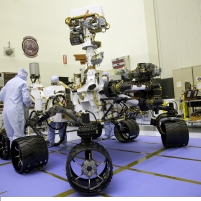NASA Launches 10 Pounds of Plutonium…Hopefully beyond the Atmosphere
Saturday, November 26, 2011
 Mars Rover Curiosity (photo: NASA)
Mars Rover Curiosity (photo: NASA)
Shortly after 10 a.m. this morning at Cape Canaveral Air Force Station in Florida, the National Aeronautics and Space Administration (NASA) will launch an Atlas V rocket on a nine-month journey to Mars. On board will be the $2.5-billion Mars Science Laboratory, a car-sized rover named Curiosity, which will study whether the environment in the landing area is suitable for microbial life. It’s an exciting scientific experiment; except for one unsettling detail…the lab is powered by 10.6 pounds of radioactive plutonium.
Should the rocket (or future rockets with similar payloads) explode at launch, it could release plutonium anywhere within 62 miles of the launch pad…including over the city of Orlando.
NASA says the danger is minimal because, even though there is a 1 in 33 chance that the launch will fail, the plutonium is well-encased and unlikely to be released.
Overall, the risk of contamination is estimated to be 1 in 420. For poker players familiar with five-card draw, that makes it less likely than being dealt a straight, but more likely than being dealt a flush.
Previous Mars rovers, launched in 1996 and 2003, were solar-powered.
-David Wallechinsky
Would a Mars Science Laboratory Launch Accident Pose a Radiation Risk? (by Joseph Castro, Space.com)
Curiosity Launch: Fukushima for Everyone? (by Karl Grossman, Truthout)
Mars Rover Plutonium Triggers Launch Precautions (by Irene Klotz, Discovery News)
- Top Stories
- Unusual News
- Where is the Money Going?
- Controversies
- U.S. and the World
- Appointments and Resignations
- Latest News
- Trump Offers to Return Alaska to Russia
- Musk and Trump Fire Members of Congress
- Trump Calls for Violent Street Demonstrations Against Himself
- Trump Changes Name of Republican Party
- The 2024 Election By the Numbers






Comments